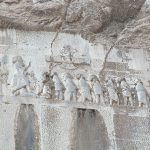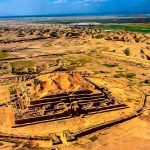was the capital of the Achaemenid Empire under Cyrus the Great (559–530 BC), who ordered its construction. It is located near the city of Shiraz, in Iran. Today it is an archaeological site and one of Iran’s UNESCO World Heritage Sites. A limestone tomb there is believed to be that of Cyrus the Great.
Cyrus the Great began building the capital in 546 BC or later; it was unfinished when he died in battle, in 530 or 529 BC. The remains of the tomb of Cyrus’ son and successor Cambyses II have been found in Pasargadae, near the fortress of Toll-e Takht, and identified in 2006.
The Gate R, located at the eastern edge of the palace area, is the oldest known freestanding propylaeum. It may have been the architectural predecessor of the Gate of All Nations at Persepolis.
Tomb of Cyrus the Great
The most important monument in Pasargadae is the tomb of Cyrus the Great. It has six broad steps leading to the sepulchre, the chamber of which measures 3.17 m long by 2.11 m wide by 2.11 m high and has a low and narrow entrance. Though there is no firm evidence identifying the tomb as that of Cyrus, Greek historians say that Alexander believed it was. When Alexander looted and destroyed Persepolis, he paid a visit to the tomb of Cyrus.
- Opens at: 07:30 – 22:00
- Entrance fee: 200,000 IRR
- Costume: no limit













